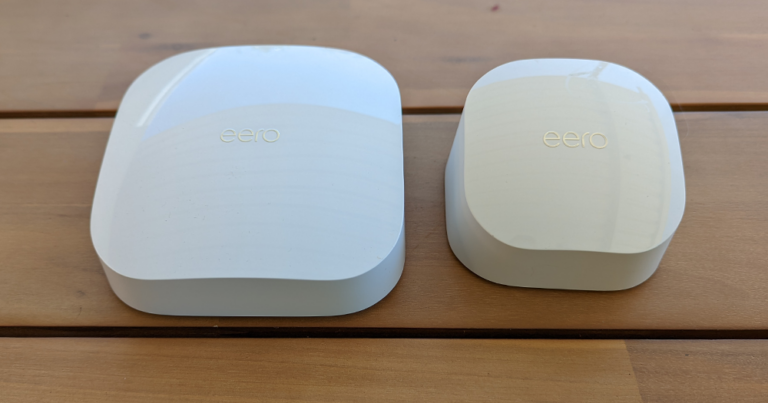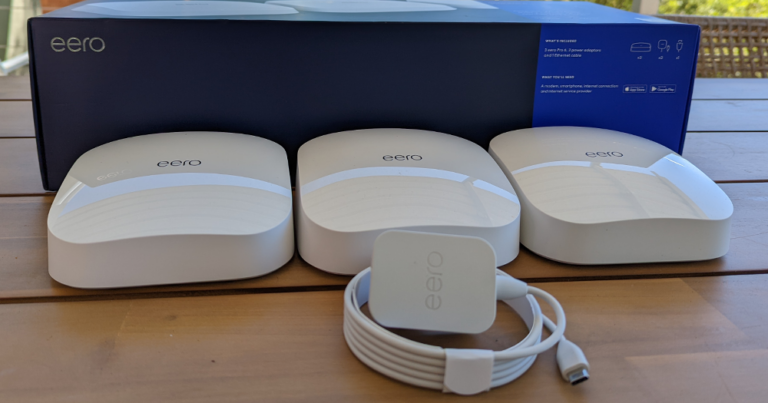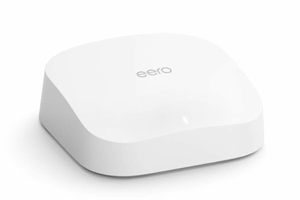No longer is powerful networks and fast internet the domain of gadget geeks. We all want fast, flawless online access, and eero knows how to make it accessible.
Amazon eero Pro 6 Review
Modems and routers used to be the domain of a select subset of geeks. Even under the umbrella term of ‘computer geek’ those interested in networking were fewer still, and very dedicated.
These days everyone wants fast internet in every room in the house. Long gone are the days when the one computer in the house could be used in one single room, now we roam from room to room, surfing as we stroll, streaming in the bedroom, bathroom, kitchen and back to the bedroom again.
The eero Pro 6 is the sort of networking system that everyone can get behind. The nodes are small and discreetly designed, it’s ridiculously easy to set up and it will make sure that you have a great experience online wherever you are in your home.
The eero team estimates that a 3-pack of eero Pro 6 routers will cover a 560 square-metre home, which should be enough for most households, with enough coverage to watch YouTube while sunbaking in the backyard. At $999, the 3-pack is one of the pricier mesh systems you can buy, and twice as expensive as the standard eero 6 system.

What’s the difference between the eero Pro 6 and the eero 6?
On the surface, there are a few key upgrades for the Pro system. For starters, all three routers in the box are exactly alike. They all have two Ethernet ports, and can be used as the primary router connected to your modem. A standard eero 6 3-pack has one primary router, with two ports, and two access points that extend your network, which don’t have any LAN ports and can’t connect to the modem.
The most important difference though is that the eero Pro six is a tri-band system, while the standard eero 6 is dual-band. Most routers these days include dual-band tech, which lets you split your devices over either the 2.4GHz frequency or the 5GHz frequency. This means you can connect more devices and share the bandwidth so that you can avoid networking bottlenecks. You can put your ‘hungrier’ devices, like laptops and Xboxes on the faster 5GHz band, and your less needy devices, like smart lights and connected whitegoods, on the 2.4GHz band.
Tri-band mesh networks include a second 5GHz band into the frequency mix so that those data hungry devices don’t have to compete on the same band. For some homes, this will be overkill. For households packed with connected devices, tri-band is a must-have.

Setting up and using the eero Pro 6
The term Pro may be enough to have everyday internet users second-guessing whether this system is for them, but let me assure you that setting up the eero Pro 6 couldn’t be simpler. Regardless of whether you are using an NBN provided modem, or a modem sent to you by your service provider, you simply plug the included Ethernet cable into your modem, and the other end into your eero, download the eero app, and follow the instructions.
There’s a bit of network handshaking to do, but none of it requires any real input from the user, and before long the network is up and running. Adding the second and third extender around your home is as easy as setting up the primary router. Just open the app, rinse and repeat.
Once everything is connected, there is surprisingly little you need to do with the app thereafter, or indeed that you can do with the app. You can easily see all of the devices connected to your network, tweak a few basic settings and access a frequently updating speed test.
For most people, this is a godsend. No strange acronyms to decipher, and no strings of numerals to remember. It just works from the moment you get online. For pro users hoping for pro level access from the eero Pro 6, they will find this all quite frustrating. This is quite a common criticism of mesh network systems, that the software smarts handle all of the complexity so that you don’t have to. But what happens when things don’t work as expected?
The fact is, some connected devices don’t like mesh networks. A number of smart home devices, like light bulbs and vacuum cleaners only operate on the 2.4GHz frequency, while other devices get great benefit from being on the 5GHz frequency. However, I’m yet to review a mesh network system that lets you specify and set the frequency for a specific device, and the eero Pro 6 is no exception. In the vast majority of instances, this is a moot point: the system assigned the device to the right band and everything works. But when you come across the outliers, it’s frustrating to not be able to take control and find a solution.
I have an ongoing problem with a Google Chromecast with Google TV, which will not play nice with any mesh network system I’ve tried. The only solution has been to avoid mesh and use a dual-band router where I can put it on a dedicated 5GHz network. None of this is the fault of any of the mesh systems it struggles with (and it’s mindboggling that this is still a problem, Google) but I was disappointed that I had the same problem when using the eero Pro 6 and lacked the control of the network to solve it.
I had a different issue with Lifx light bulbs, and without going into the details, the end result was that I didn’t have the control of the network to fix this either.
eero Secure subscription is a disappointing add-on
My biggest complaint about the eero mesh ecosystem is that a number of important features are hidden behind a subscription paywall.
eero Secure comes in two flavours: standard and eero Secure+ — and cost $2.99 or $9.99 per month respectively, with discounts for annual payments. The crux of these services fall under the banner of family security and management. You can build profiles, assign devices to these profiles, and then create filters for each. For example, a young teenager may have stricter content filters and usage limits on their tablet, then you set for an older teenager.
The Secure service can block ads, has virus and threat scanning and offers detailed usage information so you can keep tabs on which devices (and which family members) are using the most data. If you stump up the extra for Secure+ you also get subscriptions to 1Password, Malwarebytes Antivirus and Encrypt.me VPN services.
The thing is, the sort of family protection and management is the sort of thing you might expect to be baked into the eero app as standard, not something that requires an ongoing subscription to access — especially for a device bundle that costs $999. These tools will be extremely useful for some households, and withholding the functionality seems miserly.
Even the fact that you can set up Profiles and access basic usage stats in the app for free feels like lure to encourage you to pay extra. The bonus services in the Secure+ subscription are welcome and obviously add value for the money you spend, but the rest are things we’d expect built into a smart system like this.
Related Articles






